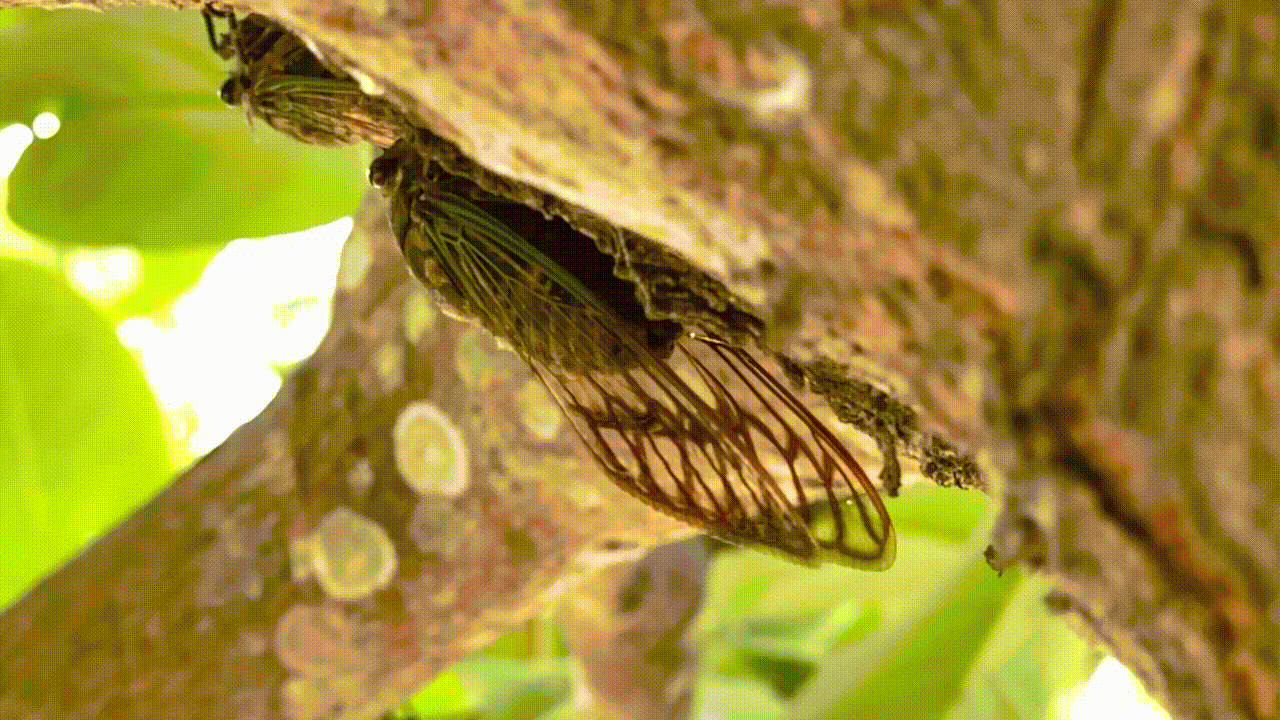Biology
Scientists Translate Sleeping Birds' Silent Songs Into Sound—and They May Have Recorded a Nightmare
Using surgically implanted electrodes and modeling, researchers brought to life the vocal muscle activity of sleeping great kiskadees
Hibernating Bumblebee Queens Can Survive Underwater for Up to a Week, Study Finds
Researchers discovered the insects’ unexpected superpower during an accidental laboratory snafu
Up to a Trillion Cicadas Could Emerge in the U.S. Later This Spring
Two specific broods will appear together for the first time since 1803
77,000 Young Salmon Were Dumped Into the Wrong Creek After a Truck Crashed in Oregon
The spring Chinook salmon smolts should still be able to find their way to the Pacific Ocean and help boost the threatened population of the fish, officials say, though another 25,000 salmon died in the accident
Florida Fish Are Mysteriously Dying After 'Spinning and Whirling,' and Scientists Can't Explain It
The abnormal behavior has raised special concerns about the endangered smalltooth sawfish, an odd-looking ray with chainsaw-like teeth, as 28 of them have died
Black-Capped Chickadees Are Masters of Memory—and Scientists Are Finding Out Why
The small birds use brain “barcodes” to remember where they stash food, according to new research
These Small Birds Flutter Their Wings to Say 'After You' to Their Partner
A new study of Japanese tits provides the first evidence of non-primate animals using gestures to convey messages
Dogs Can Understand the Words for Several Objects, Such as Toys and Leashes, Study Finds
Your dog may know the word "ball" is associated with their favorite round squishy toy, according to new research that measured brain waves
Daddy Longlegs Have Four Extra, Hidden Eyes, Researchers Say
The new discovery could help scientists unravel the mystery of how the arachnids evolved across some 537 million years
Whales That Go Through Menopause Live Longer and May Help Care for Grandchildren
Alongside humans, five species of toothed whales are known to experience menopause. A new study suggests they evolved the trait to increase their lifespan
For Most Mammal Species, Males Actually Aren't Larger Than Females, Study Finds
New research upends a long-held theory that male mammals tend to be bigger than their female counterparts
Ten Wild Facts About Octopuses: They Have Three Hearts, Big Brains and Blue Blood
These bizarre creatures have been around for hundreds of millions of years, and for humans, they’ve inspired horror, admiration and culinary prestige
Don't Look Up: Cicadas Produce High-Speed Jets of Urine
The noisy, winged insects produce pee the same way that much larger animals do, according to a new study
Fossil Hunter Discovers Gigantic Crab in New Zealand—a New, Extinct Species
The massive creature is 8.8 million years old, and its modern descendants in Australia can grow to be the weight of a human toddler
Why Don’t Humans Have Tails? An Old Genetic Mutation Could Explain Why Monkeys, but Not Apes, Have the Extra Appendage
Scientists have pinpointed a genetic change that might have led the ancestors of humans to lose their tails
Why Do Poison Dart Frogs 'Tap Dance' With Their Toes? Research Sheds Light on Feeding Time Footwork
Scientists observed frogs tapping their toes up to 500 times per minute when prey was present, suggesting the behavior is related to predation
Single Orca Spotted Killing a Great White Shark for the First Time Ever
In less than two minutes, the marine mammal attacked a juvenile white shark and ripped out its liver in an encounter off the coast of South Africa last year
The World's Smallest Vertebrate Is a Tiny Brazilian Frog, Study Finds
Adult male Brazilian flea toads are just over 7 millimeters long on average, and females measure about 8.15 millimeters
Watch This Year's 'Dance Your PhD' Contest Winner, a Musical Celebration of Kangaroo Behavior
“Kangaroo Time” took home the competition’s overall prize, while interpretive dances on early life adversity, circadian rhythms and streambank erosion were also honored
This Tiny Fish Can Make Sounds That Rival an Airplane or an Elephant—Now, Scientists Know How
Transparent and just half an inch long, male Danionella cerebrum can make noises of more than 140 decibels
Page 5 of 87
:focal(1023x565:1024x566)/https://tf-cmsv2-smithsonianmag-media.s3.amazonaws.com/filer_public/b3/fd/b3fd9f54-e937-4b9b-99f4-47ec00f4667c/40921799543_cd5d77e374_k.jpg)
:focal(1194x921:1195x922)/https://tf-cmsv2-smithsonianmag-media.s3.amazonaws.com/filer_public/c2/f1/c2f1bfd0-7ad5-4a48-8265-45f8f45901a9/common_eastern_bumble_bee_in_central_park_25454.jpg)
:focal(2567x1711:2568x1712)/https://tf-cmsv2-smithsonianmag-media.s3.amazonaws.com/filer_public/06/d6/06d6edc9-cdfa-4bb9-8caf-afb524852213/gettyimages-1321221953.jpg)
:focal(300x231:301x232)/https://tf-cmsv2-smithsonianmag-media.s3.amazonaws.com/filer_public/71/40/71404cc4-01d0-44c0-92d0-f2e0e119856f/040224_fishtankeraccident.jpg)
:focal(400x267:401x268)/https://tf-cmsv2-smithsonianmag-media.s3.amazonaws.com/filer_public/af/41/af413d12-40fb-47c2-b475-1cd918646a74/sawfish-necropsy.png)
:focal(1421x947:1422x948)/https://tf-cmsv2-smithsonianmag-media.s3.amazonaws.com/filer_public/f9/67/f967137d-8dcd-44f1-8bd0-0407051901e8/pexels-aaron-j-hill-14588460.jpg)
:focal(1060x707:1061x708)/https://tf-cmsv2-smithsonianmag-media.s3.amazonaws.com/filer_public/ce/38/ce38f5cd-f222-48c9-b6f4-97bd83fb11b1/gettyimages-1409429884.jpg)
:focal(640x427:641x428)/https://tf-cmsv2-smithsonianmag-media.s3.amazonaws.com/filer_public/71/c3/71c3994d-e0f1-47b8-a6e7-1e5593d05a4a/boxer-4214890_1280.jpg)
:focal(1024x575:1025x576)/https://tf-cmsv2-smithsonianmag-media.s3.amazonaws.com/filer_public/5d/f6/5df61598-eafd-4d89-9600-c43992cb1e01/phalangium_opilio_01_mk.jpg)
:focal(1929x1258:1930x1259)/https://tf-cmsv2-smithsonianmag-media.s3.amazonaws.com/filer_public/fc/b2/fcb2f4a1-dccc-4314-b739-e5e5b993f77b/gettyimages-547332154.jpg)
:focal(1957x1323:1958x1324)/https://tf-cmsv2-smithsonianmag-media.s3.amazonaws.com/filer_public/b3/7b/b37b38b2-5ed2-4669-8957-a961d4e7f606/gettyimages-474621363.jpg)
:focal(2007x1395:2008x1396)/https://tf-cmsv2-smithsonianmag-media.s3.amazonaws.com/filer_public/e8/88/e888c42a-fd8e-4146-ab56-f6b04cbf509a/octopus_tentacles.jpg)

:focal(710x469:711x470)/https://tf-cmsv2-smithsonianmag-media.s3.amazonaws.com/filer_public/c4/08/c40878e0-e98d-4124-b364-4911b87266ad/fossil-unearthed-in-ne.jpg)
:focal(1826x1200:1827x1201)/https://tf-cmsv2-smithsonianmag-media.s3.amazonaws.com/filer_public/b5/06/b506c654-bc56-444d-908c-109fe86fd57c/35157112900_c4830659a1_o.jpg)
:focal(2144x1429:2145x1430)/https://tf-cmsv2-smithsonianmag-media.s3.amazonaws.com/filer_public/60/15/6015c016-7397-4805-82d3-1c60d933f17c/9467039017_3ac79d7c71_o.jpg)
:focal(2550x1700:2551x1701)/https://tf-cmsv2-smithsonianmag-media.s3.amazonaws.com/filer_public/2a/0b/2a0b6c69-c2df-417e-b474-dab29dcc8fcd/gettyimages-639204074.jpg)
:focal(992x727:993x728)/https://tf-cmsv2-smithsonianmag-media.s3.amazonaws.com/filer_public/02/76/0276be0a-1b81-4c5a-91c2-223f2275e0a3/zsc12654-fig-0001-m.jpg)
:focal(608x371:609x372)/https://tf-cmsv2-smithsonianmag-media.s3.amazonaws.com/filer_public/fe/ce/fece73a9-b759-4dfe-93cd-3397925041aa/danceyourphd.jpg)
:focal(1235x584:1236x585)/https://tf-cmsv2-smithsonianmag-media.s3.amazonaws.com/filer_public/c5/cf/c5cf13b1-51fb-42a0-9454-dc43200b9ad6/12-mm-fish-produces-14.jpg)